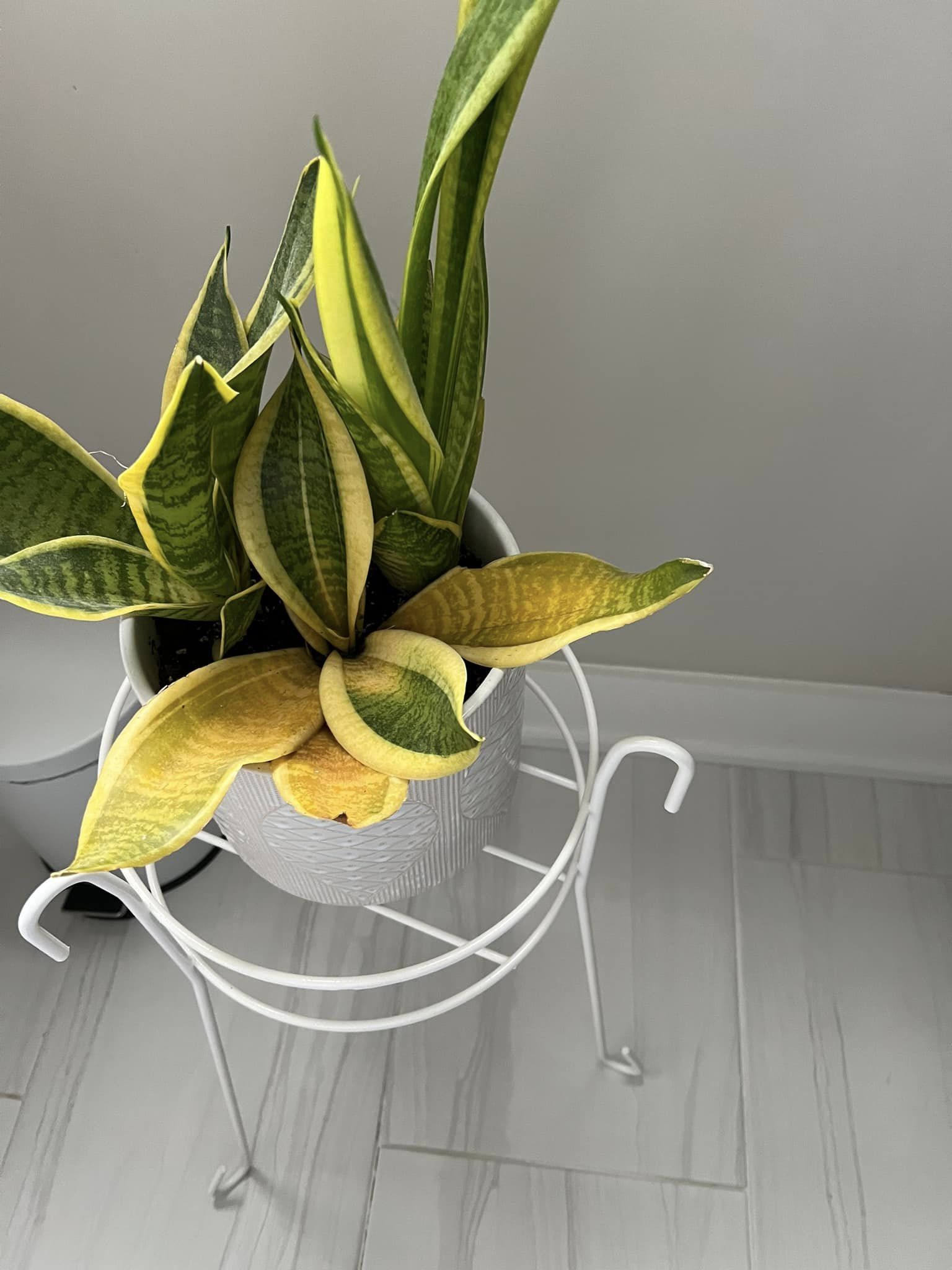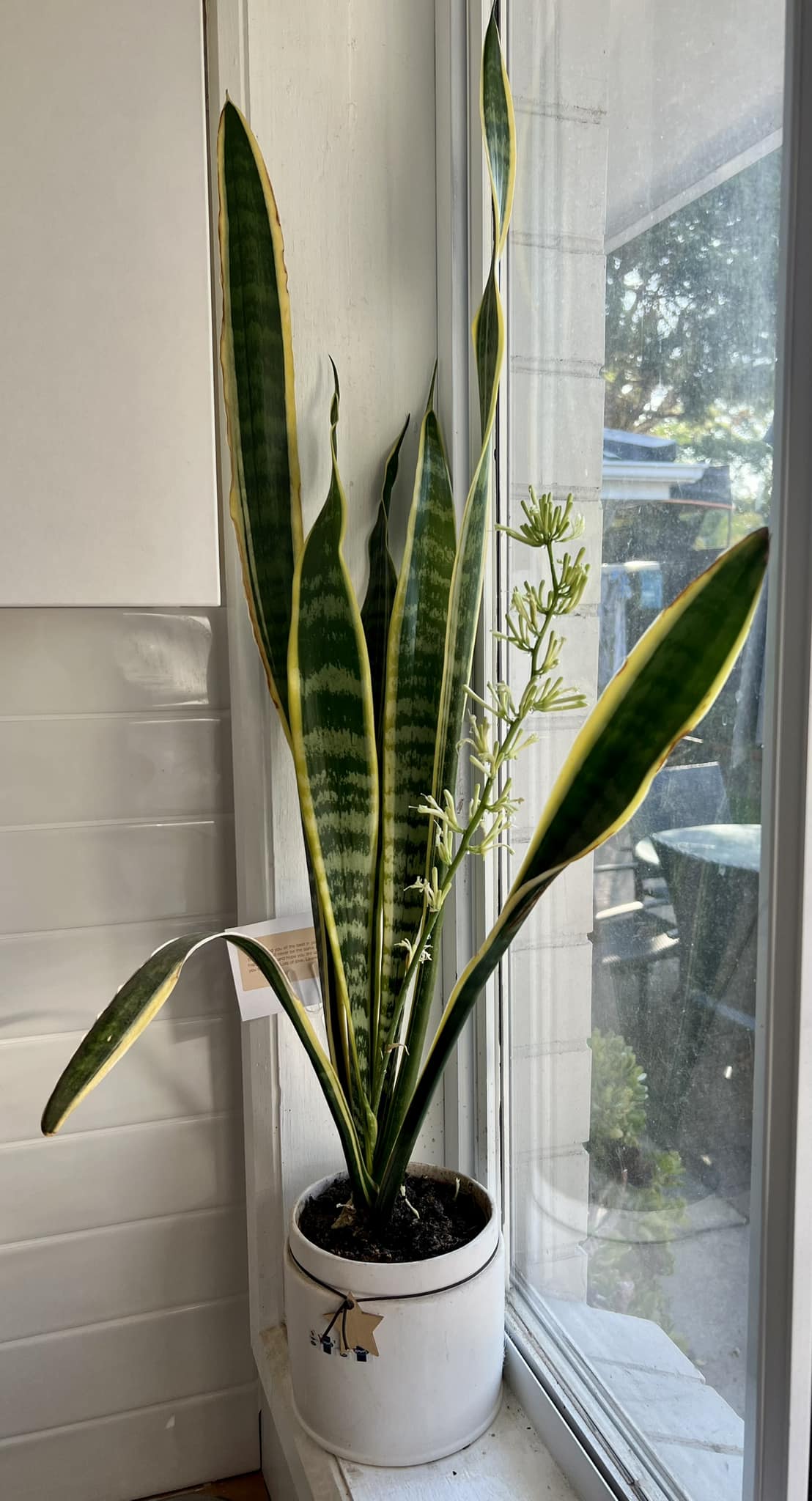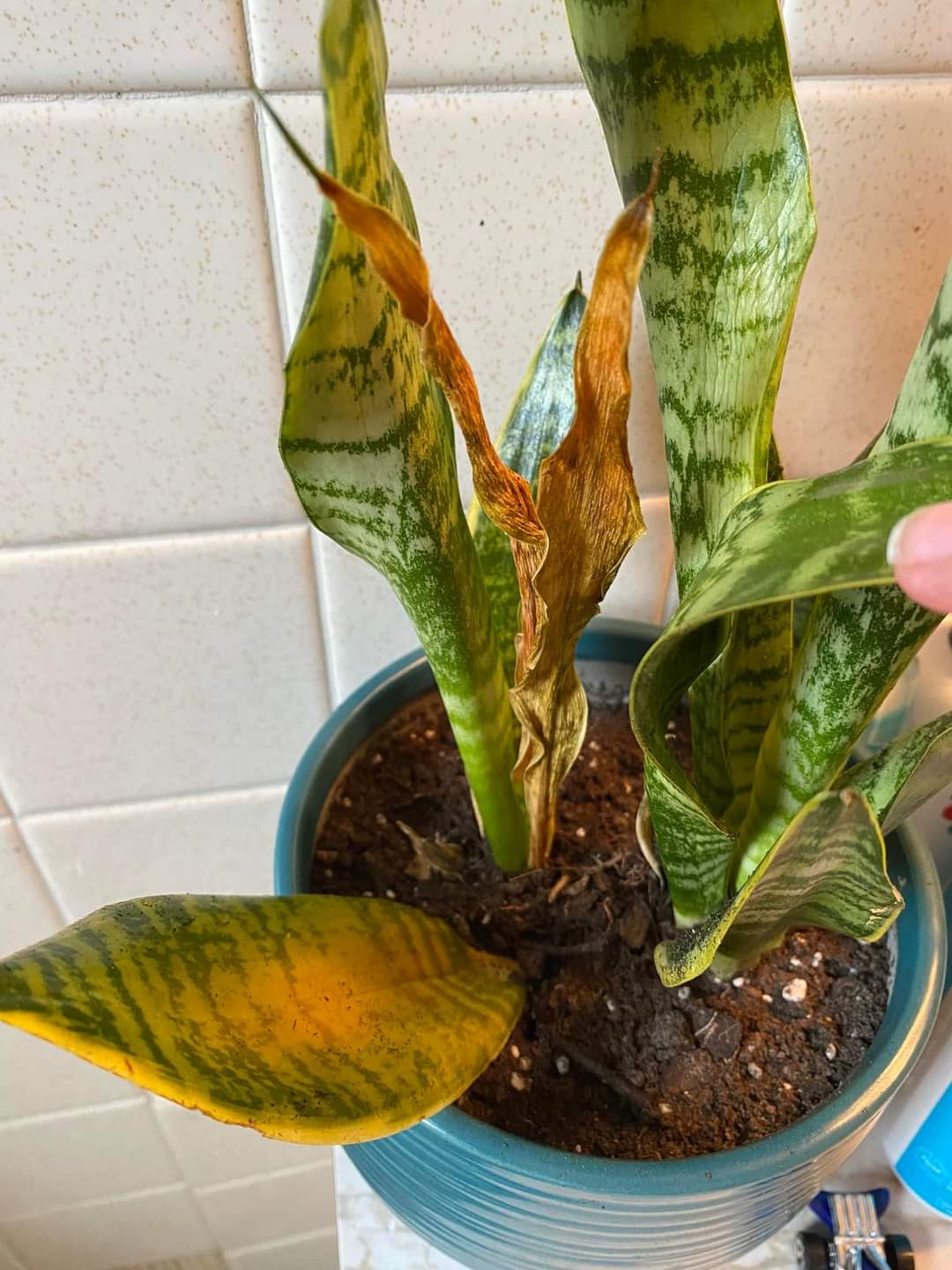Characterized by their sleek, upright leaves, often marked with intricate patterns and varying shades of green, snake plants are striking additions to indoor spaces, adding elegance and modernity to any room.
Snake plants are also virtually hard to kill, withstanding neglect, low light conditions, and even infrequent watering. But this doesn’t render them immune to problems.
Even the most well-cared-for snake plants can develop yellow leaves. If this happens, don’t panic. There are simple solutions for this issue; just take time to uncover the causes first.
Why Is My Snake Plant Turning Yellow
1. Overwatering- Enemy
So, the leaves of your snake plant are turning yellow. How often do you water it? Overwatering is a primary cause of yellowing leaves. Snake plants thrive in conditions of neglect, preferring dry spells between waterings.
The roots of your snake plant can suffocate if you subject it to over watering. Excessive moisture deprives the roots of snake plant oxygen, leading to their deterioration and subsequent leaf discoloration.
Signs of overwatered snake plant include:
- Consistently soggy or wet soil.
- Yellow or wilted leaves, especially at the snake plant’s base.
- A musty, foul-smelling soil.
Solutions
Instead of adhering to a rigid schedule, let the soil dry out partially between waterings. Also, ensure your snake plant grows in a suitable potting mix comprising equal parts of coarse sand, perlite, and potting soil.
Moreover, select your plant pots wisely. Make sure they have drainage holes and opt for terracotta pots since their porous nature promotes airflow and moisture evaporation.
Related Posts:
- Why Are My Pothos Leaves Turning Yellow?
- Why Is My Snake Plant Drooping?
- How to Make Snake Plants Grow Taller and Straight
- How to Care for Indoor Snake Plants
2. Underwatering
Overwatering your snake plant causes yellow leaves, but so can underwatering. Yes, snake plants are succulents, meaning they withstand prolonged periods of drought, but they still require soil moisture.
Underwatering manifests in desiccated soil that feels dry to the touch and exhibits visible cracks. Moreover, the leaves will begin to wilt, droop, and develop yellow or brown tips as your snake plant struggles to cope with dehydration.
Distorted foliage on a snake plant indicates chronic dehydration.
Solution
Monitor the soil moisture levels regularly and water your snake plant when the soil’s upper layer feels dry. When watering your snake plant, drench the soil until water begins to trickle through the drainage holes.
Water your plant more during periods of intense heat or low humidity to compensate for the heightened moisture loss.
3. Overexposure to Light
Snake plants typically grow in areas with bright, indirect light in their natural habitat. These adaptable plants can tolerate different light conditions, including low light and partial shade, but prolonged exposure to intense sunlight can cause damage.
Yellow leaves are an apparent symptom of excess exposure to direct sunlight. The foliage may appear pale or washed out, signaling an imbalance in light intensity. Intense sunlight can also scorch the leaves, causing brown or crispy patches. In response to overexposure to light, the leaves of your snake plant may curl or sag.
Solutions
Shield your snake plant from direct sunlight, especially during midday’s intense sun. Do so by placing it close to an east or north-facing window. This way, it can receive ample natural light without suffering exposure to direct sunbeams.
You can also shield your snake plant using blinds, window films, or sheer curtains. Alternatively, position the plant behind taller houseplants or decorative screens. Moreover, rotate your plant periodically to make sure your entire plant receives sunlight uniformly and inhibit uneven growth.
What if your snake plant doesn’t receive sufficient natural light? Supplement its lighting requirements with artificial grow lights.
4. Root Bound
If you let your snake plant outgrow its container, it will suffer root-bound. The roots of snake plants grow horizontally and spread widely. Root-bound can significantly impact their health and well-being by restricting water, oxygen, and nutrient absorption.
Root bound causes a cascade of adverse effects, including stunted growth, leaf yellowing, and general decline. It can also disrupt the soil’s drainage capacity, leading to waterlogging and soil saturation, potentially leading to root rot and further exacerbating the plant’s plight.
Solutions
Transplant your snake plant into a bigger pot with sufficient room for the expansion of roots. Gently loosen the roots before transplanting. Consider pruning the roots if severely congested to alleviate overcrowding and stimulate new growth.
5. Temperature Stress
Native to Africa’s tropical regions, snake plants thrive in humid, warm conditions. They can also tolerate harsh conditions, including drought, but are not immune to the effects of extreme or fluctuating temperatures.
Snake plants prefer temperatures ranging from 60°F to 85°F (15°C to 29°C). Exposing your snake plant to temperatures lower or higher than this range can cause adverse effects, including leaf yellowing, wilting, and overall decline.
Solutions
- Do not place your snake plant near drafty windows, air vents, or heat sources. This way, you will ensure the temperatures remain ideal for snake plant growth.
- Open windows or run fans for proper air circulation. Ample ventilation helps maintain humidity and temperature levels, which are suitable for creating a hospitable environment for the plant.
- Consider running a humidifier to control humidity levels.
6. Nutrient Deficiency
Snake plants are hardy, but if you deprive them of the necessary nutrients, this deficiency can undermine their health. A balanced nutrient supply fuels the growth of snake plants, maintains their structural integrity, and facilitates metabolic functions.
Prolonged neglect or poor soil quality can deprive your snake plant of essential nutrients—the precursors to healthy foliage and robust growth. Yellow leaves might suggest a deficiency in nutrients.
Solutions
Snake plants flourish in well-draining soil with 6.0 to 7.0 pH, so test it. Based on the soil test results, correct the nutrient deficiencies by adding appropriate fertilizers or organic amendments like compost to the soil.
7. Pests
These unwelcome, less savory intruders are a nightmare to plants and could be the reason your snake plant has yellow leaves. Leaf yellowing, particularly on older leaves, is a common sign of pest infestation. Pests that often target snake plants include spider mites, fungus gnats, mealybugs, and scale insects.
They sack the sap from the leaves and stems of snake plants, resulting in yellowing.
Solutions
If you suspect a pest infestation, isolate the affected snake plant from other houseplants to prevent the spread of pests. After that, thoroughly inspect your snake plant, focusing on the leaf’s undersides, stem joints, and soil surface.
Manually remove pests like mealybugs using a soft brush or rubbing alcohol-dipped cotton swabs and discard them afterward. You can also hose your plant to remove the pests such as aphids.
Moreover, suffocate and eradicate pests like mealybugs, scale insects, or spider mites by treating your houseplant with horticultural oils or insecticidal soaps.
8. Disease
Diseases that affect snake plants can manifest themselves as yellowing leaves. Diseases that typically cause yellow leaves in snake plants include root rot, southern blight, fusarium rot, anthracnose, and leaf spot.
Solutions
Maintain optimal growing conditions for your snake plant. For instance, facilitate proper watering, adequate ventilation, and appropriate light levels and avoid overwatering, waterlogged soil, and overcrowded growing conditions.
Monitor your spider plant regularly to detect signs of disease early and intervene promptly. If you suspect a disease outbreak, quarantine the affected plants.
Prune and remove infected plant tissues using sterilized pruning tools. Also, treat your plant with appropriate bactericides or fungicides to control diseases.
9. Overfertilization Troubles
There’s nothing wrong with loving your spider plant, but too much love in the form of excessively feeding it can be detrimental. Overfertilization leads to excessive nutrient levels, which disrupts the plant’s ability to absorb water and nutrients, leading to chlorosis characterized by yellowing or whitening of leaf tissues.
Solutions
Flush the soil with water to dilute and remove excess nutrients. Repeat this process several times to remove excess salts from the soil. Also, think about changing your plant’s potting mix and refrain from fertilizing it until it recovers.
To avoid overfertilizing your snake plant in the future, stick to a slow-release, balanced fertilizer formulated for succulent plants. During application, follow the instructions on the package and go with a weaker solution when in doubt.
10. Natural Aging
Perhaps your snake plant has yellow leaves because it’s aging. As snake plants gradually age, the older leaves turn yellow, with the yellowing typically begining at the tips or margins and progressing inward towards the base.
Besides yellowing, aging snake plant leaves may develop brown or dry patches along the edges or tips. Eventually, aging leaves droop and die. Fortunately, new leaves emerge from the plant’s center. Young snake plant leaves are light green or pale yellow, then gradually darken to deep green as they mature.
Solution
If you have been caring for your snake plant properly and the yellowing of the leaves is due to old age and nothing else, embrace the natural stages of your plant’s life. Continue caring for your snake plant and handle it with gentleness and care.
Avoid excessive handling or pruning because this can stress delicate tissues.
Summary
Seeing your beautiful snake plant exhibit yellow leaves is understandably distressing. However, since yellowing is typically one of the first signs of an issue, this gives you ample time to rectify it. Promote healthy foliage and growth by addressing the underlying problems such as overwatering, underwatering, inadequate lighting, temperature stress, nutrient deficiency, and pest infestation.

Hey there, fellow plant enthusiasts! I’m Rachel, the green-thumbed writer behind Rooted In Garden. With a deep-rooted love for all things botanical, I’ve made it my mission to help you cultivate a thriving collection of houseplants. As a devoted plant parent myself, I understand the joys and challenges that come with nurturing these leafy wonders. Whether you’re a succulent aficionado, an orchid enthusiast, or simply adore all potted flora, join me on this journey as we explore the secrets to growing and caring for our beloved green companions. Together, let’s create a flourishing oasis indoors.



